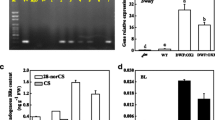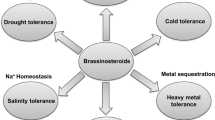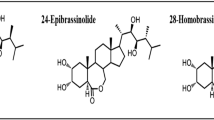Abstract
Brassinolide (BR) enhances the efficiency of photosynthetic machinery through the activation of metabolic pathways, photochemistry, and ribulose activity. However, the potential transcriptional mechanism mediating these processes through BR signaling still needed to be elucidated. In this study, we found the concealed BR-signaling mediated effects on tomato leaf morpho-physiological and biochemical traits, including chlorophyll accumulation, and photosynthetic efficiency. Under controlled conditions, the altered brassinolide sensitivity1 (abs1) mutant showed decreased leaf area and biomass associated with substantially reduced vascularization and epidermal cell size. abs1 mutant displayed significantly decreased chlorophyll accumulation and suppression in photosynthetic machinery components like photochemical quenching, electron transport rate, the maximal quantum yield of PSII photochemistry, and net photosynthetic rate. Whereas an increase in minimal fluorescence yield and non-photochemical quenching, suggests that abs1 mutant leaf has weakened abilities to harvest and transfer light energy. Moreover, the transcriptome analysis revealed differentially expressed genes involved in the chlorophyll biosynthesis and photosystem (PSI and PSII) reaction center. The abs1 mutant depicted the decreased expression level of genes encoding light-harvesting chlorophyll a/b binding proteins and photosystem II binding protein A required for the reaction center of the PSII complex. In addition, hormonal profiling of the abs1 mutant indicates the complexity of the BR and other phytohormones interactions. Our findings concluded that the BR signaling reduction transcriptionally impairs chlorophyll synthesis, quantum photon harvesting, and light energy transfer, leading to a decrease in photosynthetic capacity.






Similar content being viewed by others
Data availability
All the related data is available in the supplementary material.
References
Ahammed GJ, Yuan HL, Ogweno JO et al (2012) Brassinosteroid alleviates phenanthrene and pyrene phytotoxicity by increasing detoxification activity and photosynthesis in tomato. Chemosphere 86:546–555. https://doi.org/10.1016/j.chemosphere.2011.10.038
Axelsson E, Lundqvist J, Sawicki A et al (2006) Recessiveness and dominance in barley mutants deficient in Mg-chelatase subunit D, an AAA protein involved in chlorophyll biosynthesis. Plant Cell 18:3606–3616. https://doi.org/10.1105/tpc.106.042374
Brzezowski P, Sharifi MN, Dent RM et al (2016) Mg chelatase in chlorophyll synthesis and retrograde signaling in Chlamydomonas reinhardtii: CHLI2 cannot substitute for CHLI1. J Exp Bot 67:3925–3938. https://doi.org/10.1093/jxb/erw004
Chono M, Honda I, Zeniya H et al (2003) A semidwarf phenotype of barley uzu results from a nucleotide substitution in the gene encoding a putative brassinosteroid receptor. Plant Physiol 133:1209–1219. https://doi.org/10.1104/pp.103.026195
Dai Y, Shen Z, Liu Y et al (2009) Effects of shade treatments on the photosynthetic capacity, chlorophyll fluorescence, and chlorophyll content of Tetrastigma hemsleyanum Diels et Gilg. Environ Exp Bot 65:177–182. https://doi.org/10.1016/j.envexpbot.2008.12.008
Farag M, Najeeb U, Yang J et al (2017) Nitric oxide protects carbon assimilation process of watermelon from boron-induced oxidative injury. Plant Physiol Biochem 111:166–173. https://doi.org/10.1016/j.plaphy.2016.11.024
Feng Y, Yin Y, Fei S (2015) Down-regulation of BdBri1, a putative brassinosteroid receptor gene produces a dwarf phenotype with enhanced drought tolerance in Brachypodium distachyon. Plant Sci 234:163–173. https://doi.org/10.1016/j.plantsci.2015.02.015
Gonzalez N, de Bodt S, Sulpice R et al (2010) Increased leaf size: different means to an end. Plant Physiol 153:1261–1279. https://doi.org/10.1104/pp.110.156018
Guo F, Yu H, Xu Q, Deng X (2015) Transcriptomic analysis of differentially expressed genes in an orange-pericarp mutant and wild type in pummelo (Citrus grandis). BMC Plant Biol 15:44. https://doi.org/10.1186/s12870-015-0435-3
Gururani MA, Venkatesh J, Tran LSP (2015) Regulation of photosynthesis during abiotic stress-induced photoinhibition. Mol Plant 8(9):1304–1320. https://doi.org/10.1016/j.molp.2015.05.005
He HY, He LF, Gu MH, Li XF (2012) Nitric oxide improves aluminum tolerance by regulating hormonal equilibrium in the root apices of rye and wheat. Plant Sci 183:123–130. https://doi.org/10.1016/j.plantsci.2011.07.012
He Y, Li L, Zhang Z, Wu JL (2018) Identification and comparative analysis of premature senescence leaf mutants in rice (Oryza sativa L.). Int J Mol Sci 19(1):140. https://doi.org/10.3390/ijms19010140
Hedden P (2003) The genes of the green revolution. Trends Genet 19(1):5–9. https://doi.org/10.1016/S0168-9525(02)00009-4
Hiller RG, Wrench PM, Sharples FP (1995) The light-harvesting chlorophyll a-c-binding protein of dinoflagellates: a putative polyprotein. FEBS Lett 363:175–178. https://doi.org/10.1016/0014-5793(95)00297-M
Jaillais Y, Vert G (2016) Brassinosteroid signaling and Bri1 dynamics went underground. Curr Opin Plant Biol 33:92–100. https://doi.org/10.1016/j.pbi.2016.06.014
Jansson S (1999) A guide to the Lhc genes and their relatives in Arabidopsis. Trends Plant Sci 4:236–240. https://doi.org/10.1016/S1360-1385(99)01419-3
Järvi S, Suorsa M, Aro EM (2015) Photosystem II repair in plant chloroplasts: regulation, assisting proteins and shared components with photosystem II biogenesis. Biochim Biophys Acta Bioenergy 1847(9):900–909. https://doi.org/10.1016/j.bbabio.2015.01.006
Kalaji HM, Schansker G, Brestic M et al (2017) Frequently asked questions about chlorophyll fluorescence, the sequel. Photosynth Res 132:13–66. https://doi.org/10.1007/s11120-016-0318-y
Khandaker MM, Majrashi A, Boyce AN (2015) The influence of gibberellic acid on the chlorophyll fluorescence, protein content and PAL activity of wax apple (Syzygium samarangense var. jambu madu) fruits. Aust J Crop Sci 9(12):1221–1227
Kim T-W, Wang Z-Y (2010) Brassinosteroid signal transduction from receptor kinases to transcription factors. Annu Rev Plant Biol 61:681–704. https://doi.org/10.1146/annurev.arplant.043008.092057
Kim MH, Kim Y, Kim JW et al (2013) Identification of Arabidopsis BAK1-associating receptor-Like kinase 1 (BARK1) and characterization of its gene expression and brassinosteroid-regulated root phenotypes. Plant Cell Physiol 54(10):1620–1634. https://doi.org/10.1093/pcp/pct106
Kim D, Langmead B, Salzberg SL (2015) HISAT: a fast spliced aligner with low memory requirements. Nat Methods 12(4):357–360. https://doi.org/10.1038/nmeth.3317
Koka CV, Cerny RE, Gardner RG et al (2000) A putative role for the tomato genes DUMPY and CURL-3 in brassinosteroid biosynthesis and response. Plant Physiol 122(1):85–98. https://doi.org/10.1104/pp.122.1.85
Li J (2013) Brassinosteroids. In: Brenner’s encyclopedia of genetics: second edition, pp 19–20
Liao Y, Smyth GK, Shi W (2014) FeatureCounts: an efficient general purpose program for assigning sequence reads to genomic features. Bioinformatics 30(7):923–30. https://doi.org/10.1093/bioinformatics/btt656
Long SP, Zhu XG, Naidu SL, Ort DR (2006) Can improvement in photosynthesis increase crop yields? Plant Cell Environ 29:315–330. https://doi.org/10.1111/j.1365-3040.2005.01493.x
Montoya T, Nomura T, Farrar K et al (2002) Cloning the tomato Curl3 gene highlights the putative dual role of the leucine-rich repeat receptor kinase tBRI1/SR160 in plant steroid hormone and peptide hormone signaling. Plant Cell 14(12):3163–3176. https://doi.org/10.1105/tpc.006379
Morinaka Y, Sakamoto T, Inukai Y et al (2006) Morphological alteration caused by brassinosteroid insensitivity increases the biomass and grain production of rice. Plant Physiol 141(3):924–931. https://doi.org/10.1104/pp.106.077081
Morita R, Sato Y, Masuda Y et al (2009) Defect in non-yellow coloring 3, an α/β hydrolase-fold family protein, causes a stay-green phenotype during leaf senescence in rice. Plant J 59:940–952. https://doi.org/10.1111/j.1365-313X.2009.03919.x
Nie S, Huang S, Wang S et al (2017) Enhancing brassinosteroid signaling via overexpression of tomato (Solanum lycopersicum) SlBRI1 improves major agronomic traits. Front Plant Sci 8:1386. https://doi.org/10.3389/fpls.2017.01386
Nolan T, Chen J, Yin Y (2017) Cross-talk of Brassinosteroid signaling in controlling growth and stress responses. Biochem J 474(16):2641–2661. https://doi.org/10.1042/BCJ20160633
Shi L, Shi Y, Zhang Y, Liao X (2019) A systemic study of indoxacarb resistance in Spodoptera litura revealed complex expression profiles and regulatory mechanism. Sci Rep 9:14997. https://doi.org/10.1038/s41598-019-51234-5
Tang Y, Wen X, Lu C (2005) Differential changes in degradation of chlorophyll-protein complexes of photosystem I and photosystem II during flag leaf senescence of rice. Plant Physiol 43:193–201. Biochem. https://doi.org/10.1016/j.plaphy.2004.12.009
Tanveer M, Shahzad B, Sharma A et al (2018) 24-Epibrassinolide; an active brassinolide and its role in salt stress tolerance in plants: a review. Plant Physiol 130:69–79. https://doi.org/10.1016/j.plaphy.2018.06.035
Vert G, Nemhauser JL, Geldner N et al (2005) Molecular mechanisms of steroid hormone signaling in plants. Annu Rev Cell Dev Biol 21:177–201. https://doi.org/10.1146/annurev.cellbio.21.090704.151241
Vilarrasa-Blasi J, González-García MP, Frigola D et al (2014) Regulation of plant stem cell quiescence by a brassinosteroid signaling module. Dev Cell 30:36–47. https://doi.org/10.1016/j.devcel.2014.05.020
Voitsekhovskaja OV, Tyutereva EV (2015) Chlorophyll b in angiosperms: functions in photosynthesis, signaling and ontogenetic regulation. J Plant Physiol 189:51–64. https://doi.org/10.1016/j.jplph.2015.09.013
Wang S, Liu J, Zhao T et al (2019) Modification of threonine-1050 of SlBri1 regulates BR signalling and increases fruit yield of tomato. BMC Plant Biol 19(1):256. https://doi.org/10.1186/s12870-019-1869-9
Xia XJ, Huang LF, Zhou YH et al (2009) Brassinosteroids promote photosynthesis and growth by enhancing activation of Rubisco and expression of photosynthetic genes in Cucumis sativus. Planta 230(6):1185–1196. https://doi.org/10.1007/s00425-009-1016-1
Zhang Y, Shi Y, Gong H, jun et al (2018) Beneficial effects of silicon on photosynthesis of tomato seedlings under water stress. J Integr Agric 7:2151–2159. https://doi.org/10.1016/S2095-3119(18)62038-6
Zheng L, Gao C, Zhao C et al (2019) Effects of brassinosteroid associated with auxin and gibberellin on apple tree growth and gene expression patterns. Hortic Plant J 5(3):93–108. https://doi.org/10.1016/j.hpj.2019.04.006
Acknowledgements
We thank the Tomato Genetic Resource Center (TGRC), UC Davis, the United States for providing plant material. This work was supported by grants from the National Key Research & Development Plan (2018YFD1000800; 2016YFD0100204-21); National Natural Science Foundation of China (31991182; 31672166; 31972426); Fundamental Research Funds for the Central Universities (2662018PY073); Wuhan Frontier Projects for Applied Foundation (2019020701011492).
Author information
Authors and Affiliations
Corresponding author
Ethics declarations
Conflict of interest
The authors declare no competing financial interests and no conflict-of-interest.
Additional information
Publisher's Note
Springer Nature remains neutral with regard to jurisdictional claims in published maps and institutional affiliations.
Electronic supplementary material
Below is the link to the electronic supplementary material.
Rights and permissions
About this article
Cite this article
Mumtaz, M.A., Munir, S., Liu, G. et al. Altered brassinolide sensitivity1 transcriptionally inhibits chlorophyll synthesis and photosynthesis capacity in tomato. Plant Growth Regul 92, 417–426 (2020). https://doi.org/10.1007/s10725-020-00650-z
Received:
Accepted:
Published:
Issue Date:
DOI: https://doi.org/10.1007/s10725-020-00650-z




